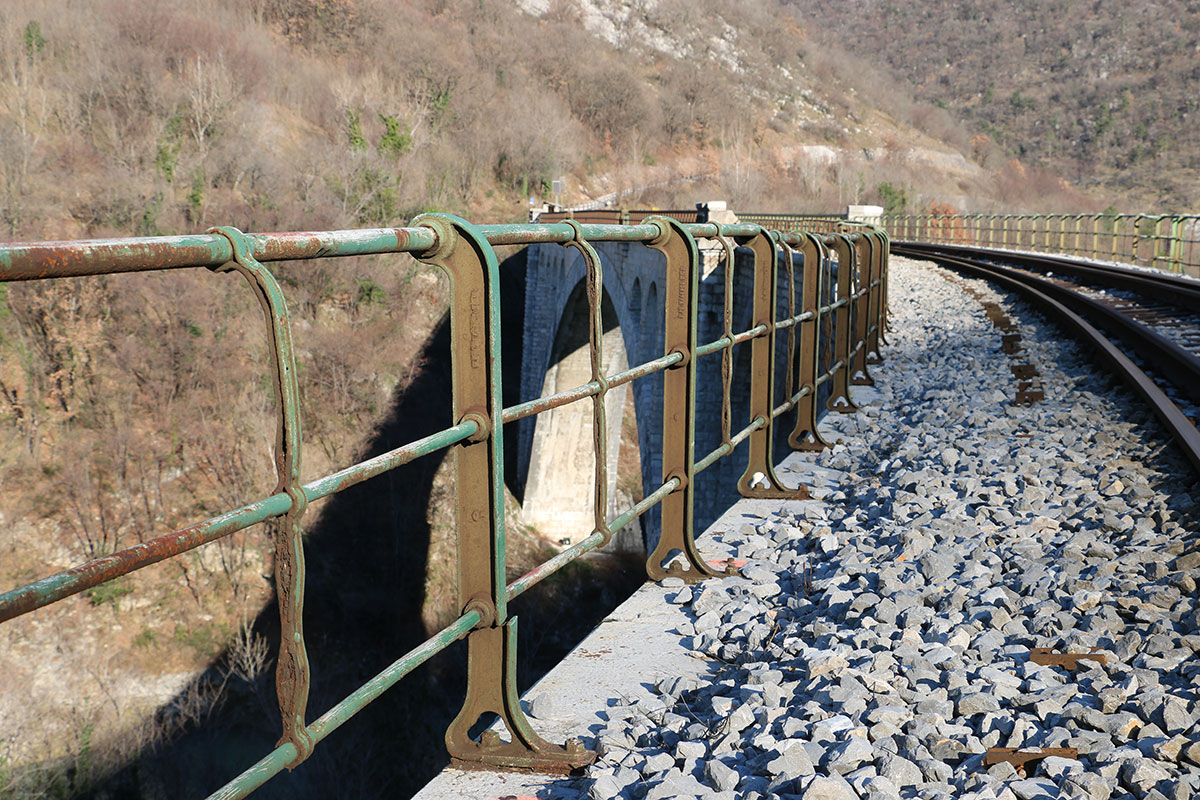TWO WAGNER'S RAILINGS ON THE SOLKAN BRIDGE
On one section of the Vienna urban railway, along the Danube Canal, were erected two types of railing. The first one was richer in design, decorated with stylized laurel wreaths and ribbons, while the second was simpler and therefore cheaper. It was placed mostly at all suburban stations of the urban railway, even in the immediate vicinity of the Schönnbrun castle. The total length was several tens of kilometres. These two types of railing, originally made for the Vienna urban railway, were also erected on the Solkan Bridge.
The first of a richer type, was erected in 1906 exclusively on the central part of the bridge, i. e. above the main arch, in a length of about 90 metres. It consisted of 32 main and 68 smaller railing pillars, which followed each other in a repeating, even rhythm. All these pillars were very impressing, and their ornaments added a decorative element to the railing. They were attached to the stone base with screws. The internal elements were decorated with stylized laurel wreaths and falling ribbons. All railing elements were made of cast iron, with the exception of the horizontal connecting beams, which were made of ordinary iron. According to the information known so far, such a railing was erected outside of Vienna only on the Solkan Bridge, which testifies to its importance in the Habsburg monarchy. It can therefore be assumed that the Solkan Bridge was dedicated to Emperor Franz Joseph I.
 Excerpt from the design of the railing that stood on the Danube Canal. It is stored in the Vienna archive as part of the documentation of the Solkan Bridge (stored by the Vienna State Archive, AdR, PlAGIuVM/LB 3.ad 26007/c).
Excerpt from the design of the railing that stood on the Danube Canal. It is stored in the Vienna archive as part of the documentation of the Solkan Bridge (stored by the Vienna State Archive, AdR, PlAGIuVM/LB 3.ad 26007/c).
The second, simpler type of railing still stands today on the Solkan Bridge to the left and to the right of the main arch. It consists of cast iron pillars bolted to a stone curb, which are connected by three ordinary iron tubes. In total, this railing on the bridge structure is about 270 meters long. Laboratory analyses carried out in Vienna have shown that the original colour, preserved under several layers of other coatings, is of the same colour as the railing pillars on the Vienna urban railway. The first layer is an anti-corrosion protection with a red lead colour, and the second layer is of beige colour. Later, an opaque green colour was applied on the Solkan Bridge, which is still visible today.
 Wagner’s railing of a simpler type on today’s Solkan Bridge (stored by Gorazd Humar).
Wagner’s railing of a simpler type on today’s Solkan Bridge (stored by Gorazd Humar).
Individual railing elements were manufactured in such a way that they were modularly included in individual segments. In this way, they could be adjusted to small inaccuracies during placement, especially in finishing works on contacts with buildings or masonry columns. For this reason, individual sections of the railing could differ in size.
The manufacturing of both types of railing was entrusted to a very-well known manufacturer of iron products and iron structures, who was also the contract manufacturer of railings for the entire Vienna urban railway. A signature with the manufacturer’s name is still visible on the preserved cast iron pillar of the Art Nouveau railing in the abbreviated form ACT. GES. R. PH. WAAGNER WIEN, meaning ACTIEN GESELLSCHAFT RUDOLPH PHILIP WAAGNER WIEN (Gesellschaft Company, Rudolph Philip Waagner, Vienna). The exact same inscription today stands on the preserved original part of the railing in the centre of Vienna. A similar inscription, only in abbreviated form, can also be found on a simpler type of railing, namely R. PH. WAAGNER WIEN. The inscription is written in visible and raised letters in the vertical direction along all the pillars.
After the Italian restoration of the arch of the Solkan Bridge in 1927, a new railing was placed on the bridge above the main arch, as it still stands today. It is made of common iron and it is no longer of cast iron as it used to be.